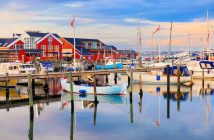This weekend, as the cold closes in on Blighty, we start our search for autumnal sun. We begin with a double bill on a particularly colourful part of the Med, as Anna Selby heads out to the Turquoise Coast…
The southwest coast of Turkey – and indeed the entire country – has been less visited by us Brits for a few years now. Time for a rediscovery? Well, with the Turkish lira at the lowest level it’s been in a decade, I’d say yes, on value for money terms alone. There are many more reasons that that, though.
For a start, if you associate Turkey with the mass tourism end of the market, you can find lots of places that don’t fit that particular bill. Take, for instance, the Turquoise Coast in the southwest and, in particular, Fethiye. This area is principally known as a yachtie paradise – hardly a surprise given the spectacular coastline where steep forested hillsides and mountains drop into a deep blue sea that often lives up to its turquoise soubriquet too.

There are little coves – some of which you can only get to from the sea – as well as spectacular long sandy beaches, such as Patara, that runs for 16km and is backed by rank upon rank of sand dunes. This is a beach you can get to by road and yet, in early June, I counted just about a dozen people along its sandy length.
In Fethiye itself, you get everything you need in terms of bars, restaurants and shopping without it being overwhelming. Many of the restaurants are strung out along the promenade facing the sea – I tried the seafood at Buzz and can recommend it. They have a stylish hotel behind the restaurant, too, but if you want to get away from it all, try Faralya, around 15 minutes from Fethiye, up in the hills for total peace and quiet.
I stayed at the Mandarin and Mango Hotel there which offers a quirky, quiet and rustic kind of luxury. The rooms are vast and most feature a fireplace for winter, a Jacuzzi big enough for six in the sitting room and four poster beds. The furniture is locally made out of olive and other local woods and Turkish rugs and kelims scatter the floors. There’s a nice pool, a lovely garden full of secret places to sit and no children under 12 to keep it nice and quiet.

From here, you can go walking in the mountains along the numerous tracks that make up the Lycian Way and, if you’d like a guide, Ghislain Sireilles, owner and creator of Mandarin and Mango and an inveterate walker, will take you. You can find different levels of Lycian Way – some are down by the sea, others higher up in the mountains – and the walks around Faralya are particularly fine. You could easily spend a week walking here every day (avoiding the hot summer months) and take in coves and seashores, rare wild flowers and wildlife (I met a wandering tortoise), natural springs and pools for swimming and Butterfly Valley, a steep-walled canyon leading to a cove with a restaurant waiting to give you a cold drink.
If you’re up for something a little more adventurous, head back down to Fethiye for a tandem paraglide off the Babadag mountain. The summit is a smidgeon under 2000m but you don’t have to jump from quite that height. The view of the amazing coastline on the way down is ranked as one of the best aerial views in the world. And if you want to see the coastline a bit more closely, you do need to get on the water. In Fethiye, there are plenty of boats for hire. You can get on a local ferry, have a scenic tour, hire your own speedboat or go for a sail.
 Back on land, you can also investigate those Lycians and especially their unique tombs, carved into the rock on the cliff faces of this mountain region. They usually have a wonderful view of the Med (they were clearly keen on a pleasant afterlife) and there are hundreds of them in the area. The tombs look pretty much as they did when they were built from around 3000BC.
Back on land, you can also investigate those Lycians and especially their unique tombs, carved into the rock on the cliff faces of this mountain region. They usually have a wonderful view of the Med (they were clearly keen on a pleasant afterlife) and there are hundreds of them in the area. The tombs look pretty much as they did when they were built from around 3000BC.
The Lycians also left a number of cities and you can still see their remains today – Telmessos, Xanthos, Pinara, Tlos, Cadianda and Patara. Later cultures (mainly Greek and Roman) moved in and made their own additions. The Lycians themselves, though, were a most unusual people. Unlike their warring neighbours, they formed the first known democratic union of 23 cities (before democracy had developed in Greece) and women had a remarkable position in society for the time, too. It is thought that Lycians used their mothers’ names rather than their fathers’ and it was a woman who presided at the national assembly every year in the city of Letoon. The founding fathers in the US were so impressed by them, in fact, they studied Lycian democracy when writing their own constitution.
Pegasus Airlines fly year-round from London to Dalaman (from just £69 one way) at www.flypgs.com/en and to another 38 destinations in Turkey including Bodrum, Izmir, Ankara and Antalya. For more information about Mandarin and Mango, visit www.villamandarin.com.
Finally, for more information on the area, visit Turkey’s official tourist website at www.gototurkey.co.uk.
Photos courtesy of Redmint Communications.




